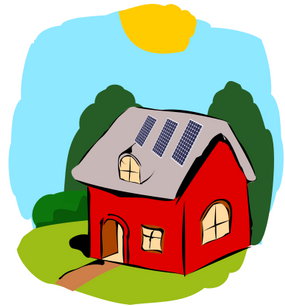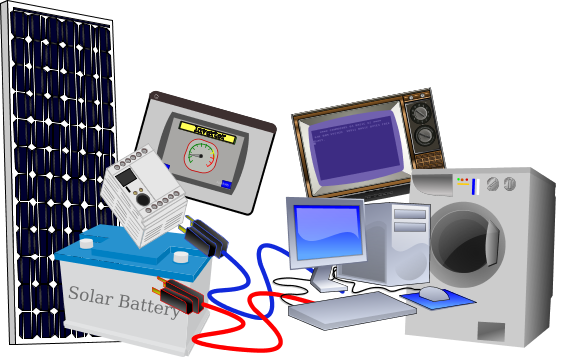Alternative Energy
Topic outline
-
This course introduces students to the alternative energy theories and concepts of some components and energy utilization in electric power system industries. It covers energy conversion, utilization and storage system for renewable technologies such as solar, wind, biomass, fuel cell, wave and etc. This course emphasis on fundamental of photovoltaic (PV) systems. It also touches upon the environmental consequences of energy conversion and how alternative energy can reduce pollution and global climate change alternative energy scenario nowadays. solar and wind resources and PV and wind turbine system components.
-
Forum
-
-
In this chapter you will be introduced about the concept and benefit of alternative energy. It will discuss the definition of alternative energy, the benefit of using an alternative energy and types of alternative energy resources and technologies.
-
Alternative Energy? Why we need to turn to alternative energy instead of fossil fuel that most people are using today. In this module, you will be introduced about the basic understanding about alternative energy concept.
After completing this module, you should be able to:
Describe the definitions and the concept of alternative energy
List several types of alternative energy technologies
Explain the advantages and disadvantages of alternative energy


-
Chat
In this chapter, you have been introduced several types of alternative energy resources and technologies. Although alternative energy systems have many positive impacts on our environment, however, the process to develop such a system can contribute to negative impact on the environment.
Share your idea on this issue. Choose one type of alternative energy and chat with me
-
-
This chaptervcovers about solar energy resource and site analysis. At the end of this module, you should be able to analyze solar energy resource and to do site analysis. You will be explained about the concept of solar energy and how to assess the amount of solar energy that available at a particular site. Therefore, a comprehensive discussion is given to the sun geometry and sun path analysis. Next, the discussion focuses on to finding the best solar module orientation in order to get maximum solar energy. Finally, you will exposed to various types of measuring tools or equipment for collecting the energy from the sun.
-
The sun produces about 3.8 kW of power in huge nuclear fission reactions. However, this huge energy lost in space. About 1.73 kW of the energy reach the earth's surface. The amount of solar energy that reached the earth's surface is more than enough to provide all of energy needs. The energy from the sun can be harvested and used for heating, drying, cooking, raising steam, distilling and generating electricity. This module is concerned with the basic principles of solar energy. In generating electricity, the solar energy normally referred to the amount of solar radiation. Solar radiation is composed of millions of high-energy particles called photons. Also discussed in this module is finding the sun path to get the best orientation of the solar collectors.

-
Forum
The amount of solar energy received by a solar module changes depend on location and time. Can you find the reason? Share your finding.
-
-
This chapter explains about the principle of photovoltaic (PV) and a PV cell works to produce electricity. It also discusses the fundamental concept of a PV cell, module, array and factors that affect to the system performances
-
You will be introduced about solar cell technology, various types of solar cells, and the factors that will affect the performance of PV cells. Solar cells are made from semiconductor materials. The most widely used semiconductor material in solar cell production is silicone. It is important to consider the advantages and disadvantages of various types of solar cell when choosing the PV modules. It is very important to be aware of the PV cells/modules characteristics, especially when designing the PV system. Every type of PV cell has a unique and has its own individual characteristic.
-
This part will deeply focus on the PV cell and module characteristics. The performance of a PV cell/module is affected by a variety of factors. However, the most significant factors are due to the effect of cell temperature and irradiance. These two factors should be studied carefully since the data specification of the PV modules are given at standard test condition (STC). The actual outputs of the PV module could be different since the environmental conditions are different. So, it is paramount important to estimate the output prior installation of the PV system.

-
Download question
-
At the end of this part, you should be able to understand some critical issues that can affect the performance of PV module. Generally, PV modules are connected in series-parallel connections for getting a higher output voltage and current. What happens if one part of the cells are shaded or faulty? How to prevent formation of hotspot in a PV module?
-
-
This chapter discusses the components required for developing different types of PV systems. You will be introduced with different PV system configurations and their corresponding components needed for developing the system. For each of the components, we will discuss and examine their special features and characteristics before deciding to use in our PV system. Finally, this module also covers the system cabling and protection devices that according to the recommended regulations
-
Generally, PV systems are divided into two major categories, which are grid-connected systems (also known as grid-tied) and stand-alone systems. The PV system configuration depends on the type of system we are using. In grid-connected system, the selection the types of inverters play an important role in designing the optimal system's configuration. While for stand-alone system, the system configuration will depend on the size of the battery. An emphasis of this part is on different types of PV system configurations and the functional principles of the different types of inverters.
-
This part discusses all components and devices that are commonly used in a PV system. Once again, the selection of component will depend on the type of system either grid-connected or stand-alone system. Before we decide to use the components, first we need to understand the its function and specifications. The next step is how to interconnect all the components to become a complete a system. The integration of all components is known as balance of system (BoS) and often it must comply with codes and regulations (either local or national standards). Follow this video to get further detail.

-
File
Download the question
-
This part explains about PV system cabling and protection. The electrical connections in a system may be inconspicuous, but their effects should not be underestimated. As a relatively large number of electrical connections are required in order to connect the modules of a PV plant to the inverter, the losses at contact points can add up. Long-lasting, secure cable connections with low contact resistances are necessary to avoid defects, losses and accidents. Protection devices are required for the system safety, especially for the system components to protect from surge current.


-
File
Download the question
-
-
PV system can be categorized into two groups which are grid-connected system and stand-alone system. Grid-connected PV system is a system that works in with the utility grid when the PV module get enough energy from the sun to generate electricity. On the other hand, stand-alone PV system operates independently without grid connection. In most applications, PV modules are used to charge a bank of batteries as a power backup. This chapter includes detailed system sizing calculations, balance of system, and system protection for the stand-alone PV systems.

-
PV stand-alone or off-grid system commonly used in rural or remote areas where main power is not available due to long distance and high cost of main grid extension. The systems use solar power to charge batteries. The energy stored in the batteries is used when needed to operate electrical appliances. Stand-alone systems can range in size from a single PV module up to very large system incorporating sophisticated control equipment and large back-up generating sets. This part gives an introduction about the PV stand-alone system.

-

This part will guide you to design a PV stand-alone system. The first step is to do a load assessment which is the daily requirement for electricity by each of the appliances. From here, we can calculate the size of the system. This includes the size of the battery and the PV array.

-
-
This chapter provides a comprehensive discussion in the design of grid-connected PV systems. It covers all aspects of grid-connected PV system design. You will be introduced how to properly determine the correct size of a grid-connected PV system according to different design criteria. Besides, this module will also discuss different types of grid-connected inverters, their unique characteristics, how to choose the suitable inverter for the system and why, as well installation techniques and specifics. Finally, a comprehensive discussion on how to determine the optimal number of PV modules and how to integrate all of these components as well as finding the best wiring configuration
-

This part deals with the steps required for designing a grid-connected photovoltaic system. The important aspects will be discussed starting with the site survey and choosing the type of configuration before sizing the system. Finally, we find the optimal system sizing in which it will produce the best output performance.
-
In the previous part, we have determined the number of PV modules required to fulfill the requirement. However, the final number of PV modules will be dependent on the selection of the inverter and the specific number of PV modules that can be connected in series-parallel configuration to that inverter. This part shows you how to match between PV array and grid inverter. Here, we have to understand the characteristic of the inverter. Grid inverters normally have a voltage operating window with a specified minimum voltage and maximum voltage. The operating voltage of the PV array must be within this range. Some inverter state the maximum voltage which is the highest voltage limit where the inverter could be damaged if the operating voltage reached this limit. Therefore, it is critical that the output voltage of the PV array is matched to the operating voltages of the inverter and not exceed to the maximum voltage of the inverter.

-
Find the optimum number of series-parallel PV module configuration between Fronius IG40 Inverter and BP380 PV modules (Refer to datasheet below). Assume the maximum and minimum cell effective temperatures recorded at the site are 65˚C and 20˚C, respectively. The maximum solar irradiance is 900 W/m2. (Assume the safety factor is equal to 1).
Datasheet : BP 380 PV Module Datasheet
-
The rating of commercial PV modules is given for Standard Test Conditions (STC). In practice PV systems rarely operate at STC, due to variations in ambient conditions. Therefore, we need to estimate the performance of the PV system. In this part, the effects of various factors under real operating conditions as well as power losses in the system will be highlighted. This will be followed by an assessment of the energy production of a grid-connected PV systems.

-
-
This chapter provides fundamental concept of hybrid PV system. It gives insight into hybrid system configurations. The module also discussed by considering different types of hybrid system technology. In addition a set of student exercises deals with advantages and disadvantages of utilizing a hybrid system.
-
To meet the load demands at all times, it is greatly enhanced by the hybrid system which is by using more than one power source. Most hybrid PV systems use diesel generator or wind, since diesel provides more predictable power on demand. In some hybrid systems, batteries are commonly used in addition to the diesel generator. The batteries meet the daily load fluctuation, and the diesel generator takes care of the long-term fluctuations. This chapter discusses the basic concept of hybrid PV system. It covers the configuration of hybrid system, type of hybrid system and the advantages and disadvantages of hybrid system.

-
Forum
On economic perspective, do you think that a hybrid system is more cost effective than a single power generation system. Let's discuss and share your idea. (Not more than 100 words)
-
